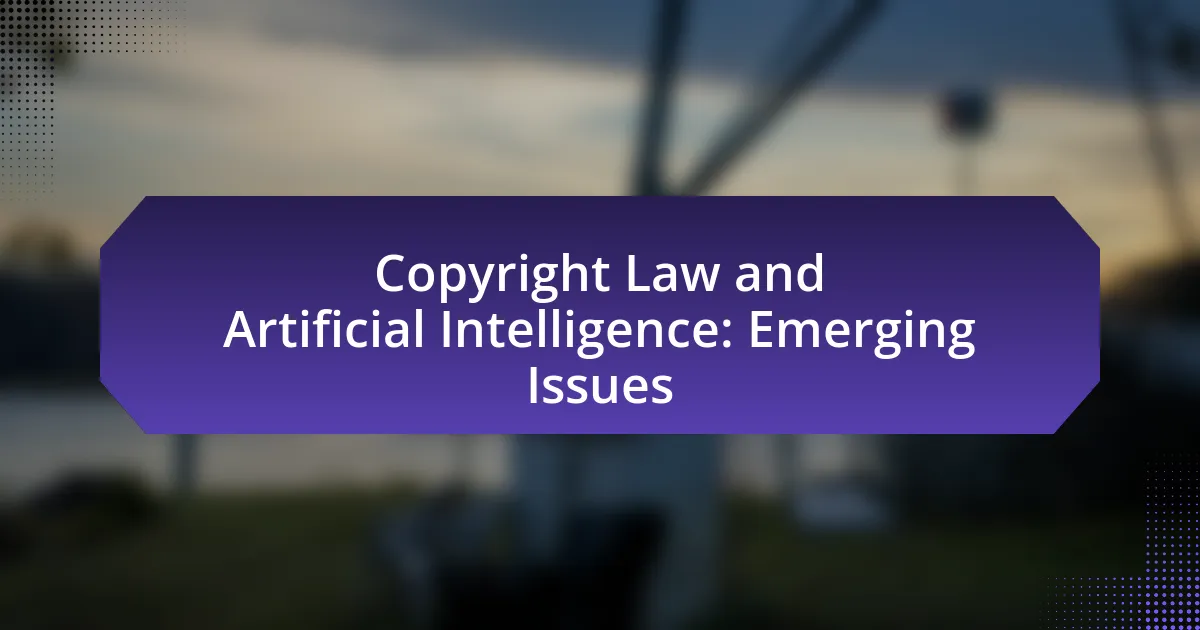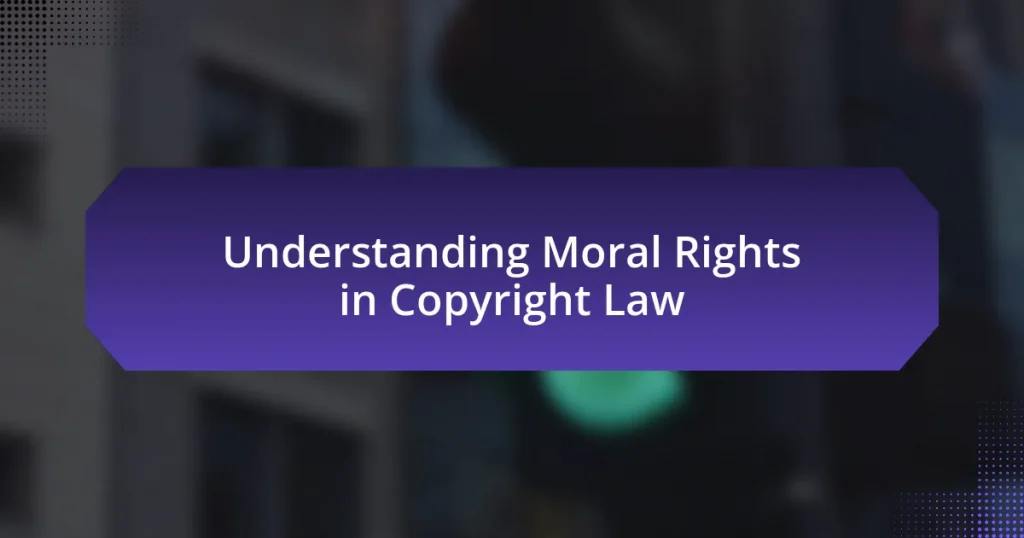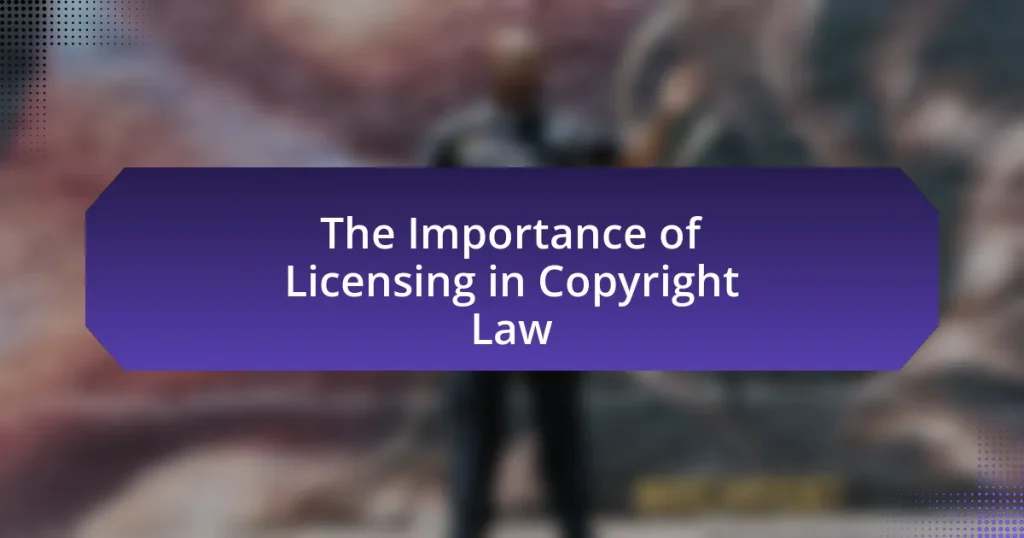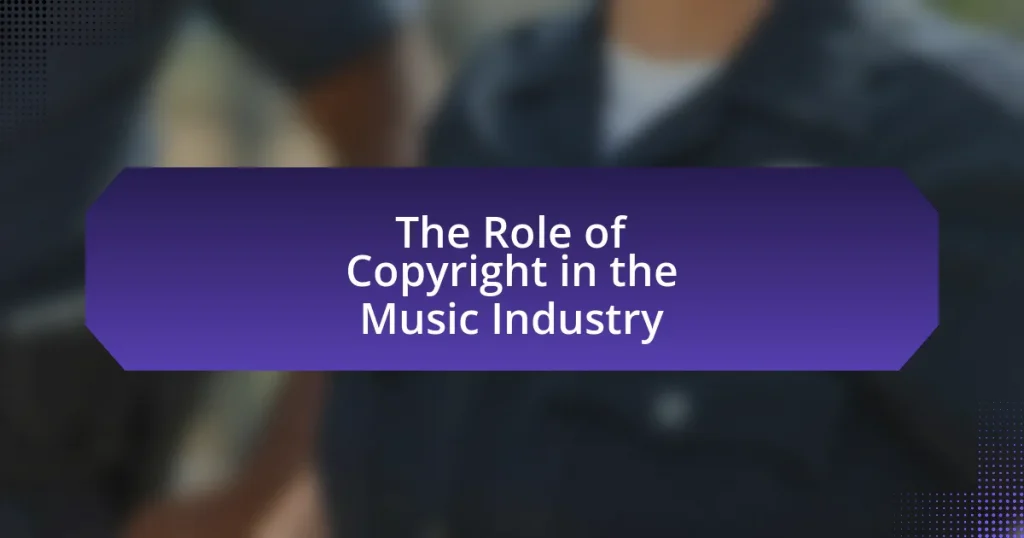The article focuses on the intersection of Copyright Law and Artificial Intelligence, highlighting emerging issues related to authorship, ownership, and copyright infringement. It outlines the fundamental principles of Copyright Law, including the protection of original works, exclusive rights for creators, and the concept of fair use. The article also examines how AI challenges traditional copyright frameworks, the implications of AI-generated content on ownership rights, and the potential benefits of integrating AI in copyright enforcement. Additionally, it discusses recent legal cases and proposed legislative changes aimed at addressing the complexities introduced by AI in the creative process.

What are the fundamental principles of Copyright Law?
The fundamental principles of Copyright Law include the protection of original works of authorship, the exclusive rights granted to creators, and the limitation of those rights through fair use. Copyright Law safeguards the expression of ideas in various forms, such as literature, music, and art, ensuring that creators have the exclusive right to reproduce, distribute, and display their works. This legal framework is designed to incentivize creativity and innovation by granting authors control over their creations for a specified duration, typically the life of the author plus 70 years. Fair use serves as a critical limitation, allowing limited use of copyrighted material without permission for purposes such as criticism, comment, news reporting, teaching, scholarship, or research, thereby balancing the interests of creators and the public.
How does Copyright Law protect creative works?
Copyright Law protects creative works by granting creators exclusive rights to their original expressions, including the right to reproduce, distribute, and display their works. This legal framework ensures that authors, artists, and other creators can control the use of their creations, thereby incentivizing innovation and creativity. For instance, under the U.S. Copyright Act of 1976, works such as literature, music, and visual arts are automatically protected upon creation, without the need for registration. This automatic protection is reinforced by the ability to seek legal remedies against unauthorized use, which serves as a deterrent against infringement and promotes respect for intellectual property.
What types of works are eligible for copyright protection?
Copyright protection is eligible for original works of authorship fixed in a tangible medium of expression. This includes literary works, musical compositions, dramatic works, choreographic works, pictorial and graphic works, audiovisual works, sound recordings, and architectural works. The U.S. Copyright Act of 1976 outlines these categories, emphasizing that the work must be original and demonstrate a minimal degree of creativity to qualify for protection.
How long does copyright protection last?
Copyright protection lasts for the life of the author plus 70 years after their death. This duration applies to works created after January 1, 1978, as established by the Copyright Act of 1976 in the United States. For works created by corporate authors or anonymous works, copyright lasts for 95 years from publication or 120 years from creation, whichever is shorter. These timeframes ensure that creators and their heirs can benefit from their works for a significant period while eventually allowing public access.
What are the limitations and exceptions in Copyright Law?
Limitations and exceptions in Copyright Law include fair use, educational use, and the first sale doctrine. Fair use allows limited use of copyrighted material without permission for purposes such as criticism, comment, news reporting, teaching, scholarship, or research. Educational use permits the use of copyrighted works in a classroom setting under specific conditions. The first sale doctrine allows the resale of copyrighted works after their initial sale without the copyright holder’s permission. These limitations and exceptions are designed to balance the rights of copyright holders with public interest and access to information.
What is the concept of fair use in copyright?
The concept of fair use in copyright allows limited use of copyrighted material without permission from the rights holder. This legal doctrine is primarily defined by four factors: the purpose and character of the use, the nature of the copyrighted work, the amount and substantiality of the portion used, and the effect of the use on the market for the original work. Fair use is often applied in contexts such as criticism, comment, news reporting, teaching, scholarship, or research, and is intended to balance the interests of copyright owners with the public’s interest in the dissemination of information. The validity of fair use is supported by numerous court cases, including the landmark case of Campbell v. Acuff-Rose Music, Inc., which established that transformative use can qualify as fair use.
How do public domain and Creative Commons licenses work?
Public domain works are not protected by copyright, allowing anyone to use them without permission or payment. This status can occur when copyright expires, or the creator explicitly places their work in the public domain. Creative Commons licenses, on the other hand, are a set of licenses that allow creators to grant specific usage rights while retaining some rights. These licenses range from allowing any use with attribution to restricting commercial use or derivative works. The flexibility of Creative Commons licenses enables creators to share their work while controlling how it is used, promoting collaboration and access to knowledge.

How is Artificial Intelligence impacting Copyright Law?
Artificial Intelligence is significantly impacting copyright law by challenging traditional notions of authorship and ownership. AI-generated works raise questions about whether the creator of the AI, the user, or the AI itself holds copyright. For instance, the U.S. Copyright Office has stated that works created by AI without human intervention may not qualify for copyright protection, as seen in the case of the AI-generated artwork “Edmond de Belamy.” This situation illustrates the need for legal frameworks to adapt to the complexities introduced by AI, as existing laws were designed for human creators and do not adequately address the nuances of machine-generated content.
What challenges does AI pose to traditional copyright frameworks?
AI poses significant challenges to traditional copyright frameworks by complicating the attribution of authorship and ownership of creative works. Traditional copyright laws are designed around human creators, but AI-generated content raises questions about whether the AI itself, its developers, or users hold copyright. For instance, the U.S. Copyright Office has stated that works created solely by AI without human intervention are not eligible for copyright protection, highlighting the legal ambiguity surrounding AI-generated works. Additionally, the ability of AI to replicate and remix existing works can lead to potential copyright infringement issues, as it may be difficult to determine the extent of originality in AI outputs. This evolving landscape necessitates a reevaluation of existing copyright laws to address the unique characteristics of AI-generated content and its implications for intellectual property rights.
How does AI-generated content fit within existing copyright laws?
AI-generated content currently occupies a complex position within existing copyright laws, primarily because copyright protection traditionally requires human authorship. The U.S. Copyright Office has stated that works created solely by AI without human intervention do not qualify for copyright protection, as seen in the 2022 case involving the AI-generated artwork “A Recent Entrance to Paradise.” This indicates that while AI can assist in content creation, the legal framework still necessitates a human creator to claim copyright. Additionally, the legal status of AI-generated works may evolve as courts and lawmakers address the implications of AI in creative processes, reflecting ongoing debates about authorship and ownership in the digital age.
What are the implications of AI on authorship and ownership rights?
AI significantly complicates authorship and ownership rights by challenging traditional definitions of creativity and originality. As AI systems generate content autonomously, questions arise regarding who holds the copyright—whether it is the developer of the AI, the user who prompted the AI, or the AI itself. Current copyright laws, such as the U.S. Copyright Act, require a human author for protection, which creates ambiguity when AI is involved. For instance, in 2019, the U.S. Copyright Office ruled that works created by AI without human intervention are not eligible for copyright, highlighting the legal gap in addressing AI-generated content. This situation necessitates a reevaluation of existing laws to accommodate the unique nature of AI contributions, potentially leading to new frameworks for intellectual property rights that recognize AI’s role in the creative process.
What are the potential benefits of integrating AI with Copyright Law?
Integrating AI with Copyright Law can enhance efficiency in copyright management and enforcement. AI technologies can automate the detection of copyright infringement by analyzing vast amounts of digital content, identifying unauthorized use of copyrighted materials, and streamlining the process of issuing takedown notices. For instance, platforms like YouTube utilize AI algorithms to scan uploaded videos for copyrighted music and images, significantly reducing the time and resources needed for manual monitoring. Additionally, AI can assist in the creation of more precise copyright policies by analyzing trends in content usage and user behavior, thereby helping lawmakers adapt to the evolving digital landscape. This integration ultimately leads to better protection for creators and more effective compliance with copyright regulations.
How can AI assist in copyright enforcement and monitoring?
AI can assist in copyright enforcement and monitoring by automating the detection of unauthorized use of copyrighted materials across various platforms. Machine learning algorithms can analyze vast amounts of data, identifying patterns and similarities between original works and potential infringements. For instance, tools like Content ID used by YouTube leverage AI to scan uploaded videos against a database of copyrighted content, automatically flagging or removing infringing material. This technology significantly reduces the time and resources required for manual monitoring, allowing copyright holders to protect their intellectual property more effectively.
What role does AI play in content creation and originality?
AI significantly enhances content creation by automating processes and generating original material. It utilizes algorithms to analyze vast datasets, enabling the production of text, images, and videos that can mimic human creativity. For instance, AI tools like OpenAI’s GPT-3 can generate coherent and contextually relevant text, demonstrating the capability to create original content that can pass as human-written. Furthermore, studies indicate that AI-generated content can achieve high levels of originality, with some AI systems producing unique outputs that do not directly copy existing works, thus raising important questions regarding copyright and ownership in the digital age.
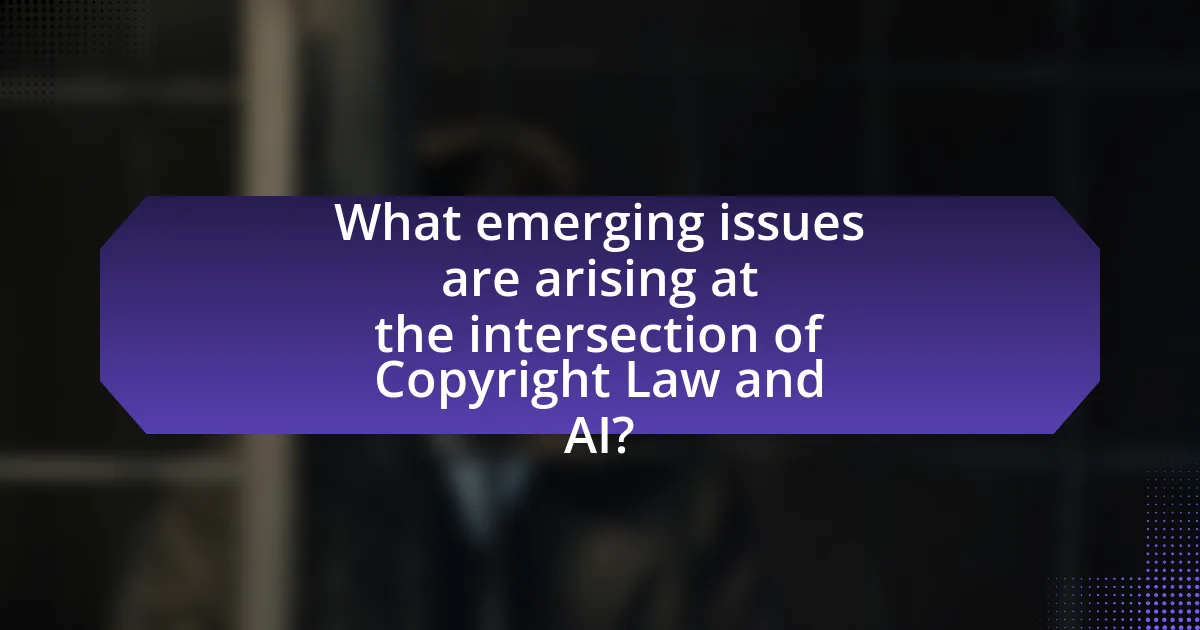
What emerging issues are arising at the intersection of Copyright Law and AI?
Emerging issues at the intersection of Copyright Law and AI include the challenges of authorship attribution, ownership rights, and the potential for copyright infringement by AI-generated content. As AI systems create original works, questions arise regarding whether the AI itself can be considered an author under existing copyright frameworks, which traditionally recognize human creators. Additionally, the ownership of works produced by AI raises concerns about who holds the rights—developers, users, or the AI itself. Furthermore, the risk of AI inadvertently reproducing copyrighted material during the content generation process poses significant legal implications, as seen in cases where AI tools have generated outputs closely resembling existing copyrighted works. These issues highlight the need for legal reform to address the unique characteristics of AI-generated content within the current copyright landscape.
How are courts and lawmakers responding to AI-related copyright disputes?
Courts and lawmakers are increasingly addressing AI-related copyright disputes by evaluating the applicability of existing copyright laws to AI-generated works. Recent cases, such as the U.S. Copyright Office’s refusal to grant copyright to a work created solely by an AI, highlight the ongoing debate about authorship and originality in the context of AI. Lawmakers are also considering new legislation that clarifies the rights of creators and the status of AI-generated content, as seen in proposals aimed at updating copyright frameworks to accommodate technological advancements. These responses reflect a growing recognition of the need to adapt legal standards to the complexities introduced by artificial intelligence in creative processes.
What recent cases highlight the tension between AI and copyright law?
Recent cases that highlight the tension between AI and copyright law include the case of “Thaler v. Commissioner of Patents,” where the Australian Federal Court ruled that an AI system could not be recognized as an inventor under current patent laws, emphasizing the legal ambiguity surrounding AI-generated works. Additionally, the “Getty Images v. Stability AI” case raised questions about copyright infringement when AI-generated images were created using copyrighted photographs without permission, illustrating the conflict between AI technology and existing copyright protections. These cases underscore the ongoing legal challenges and the need for updated copyright frameworks to address the implications of AI in creative processes.
How are different jurisdictions approaching AI and copyright issues?
Different jurisdictions are approaching AI and copyright issues through varying legal frameworks and interpretations. For instance, the United States has largely maintained that copyright protection applies to works created by human authors, leading to debates about whether AI-generated content qualifies for copyright. In contrast, the European Union is exploring more inclusive frameworks, as seen in the EU’s Copyright Directive, which aims to address the challenges posed by AI in creative industries. Additionally, countries like the United Kingdom have begun to consider specific provisions for AI-generated works, indicating a shift towards recognizing the unique nature of AI contributions. These approaches reflect a broader trend of adapting existing copyright laws to accommodate the complexities introduced by artificial intelligence in creative processes.
What future trends can we expect in Copyright Law as it relates to AI?
Future trends in Copyright Law as it relates to AI include the establishment of clearer guidelines for the ownership of AI-generated content and the adaptation of existing copyright frameworks to address the unique challenges posed by AI technologies. As AI systems increasingly create original works, legal systems are likely to evolve to define whether the AI, its developers, or users hold copyright. For instance, the U.S. Copyright Office has already indicated that works created solely by AI may not qualify for copyright protection, prompting discussions on potential legislative reforms. Additionally, there may be an increase in licensing agreements specifically tailored for AI-generated content, reflecting the need for new business models in the digital economy. These trends are driven by the rapid advancement of AI capabilities and the growing importance of intellectual property rights in the tech industry.
What legislative changes are being proposed to address AI in copyright?
Legislative changes proposed to address AI in copyright include the introduction of new frameworks that clarify the ownership of works generated by artificial intelligence. These frameworks aim to establish whether AI-generated content should be protected under existing copyright laws or if new categories of protection are necessary. For instance, the European Union’s proposed Copyright Directive includes provisions that consider the role of AI in content creation, suggesting that creators of AI systems may hold rights over the outputs generated by their technologies. Additionally, discussions in the United States have focused on updating the Copyright Act to explicitly address the implications of AI, ensuring that both human and machine contributions are recognized in copyright claims.
How might technological advancements further complicate copyright issues?
Technological advancements complicate copyright issues by enabling easier reproduction and distribution of copyrighted materials, often without proper authorization. For instance, the rise of artificial intelligence allows for the creation of content that closely mimics existing works, leading to challenges in determining originality and ownership. Additionally, digital platforms facilitate the rapid sharing of content, making it difficult for copyright holders to monitor and enforce their rights effectively. According to a report by the World Intellectual Property Organization, the proliferation of user-generated content and AI-generated works raises significant questions about the applicability of existing copyright frameworks, highlighting the need for legal adaptations to address these emerging complexities.
What best practices should creators follow regarding Copyright Law and AI?
Creators should ensure they understand and comply with copyright law when using AI-generated content. This includes obtaining necessary licenses for any copyrighted material used in training AI models, as well as ensuring that the output generated by AI does not infringe on existing copyrights. For instance, creators should be aware that AI-generated works may still be subject to copyright if they closely resemble existing works. Additionally, creators should document their processes and sources to establish clear ownership and rights over their AI-generated content. This practice is supported by the U.S. Copyright Office, which emphasizes the importance of originality and authorship in copyright claims.
How can creators ensure compliance with copyright when using AI tools?
Creators can ensure compliance with copyright when using AI tools by obtaining proper licenses for any copyrighted material they intend to use and by understanding the limitations of fair use. Licensing agreements provide legal permission to use specific works, while fair use allows limited use of copyrighted material without permission under certain conditions, such as commentary, criticism, or educational purposes. According to the U.S. Copyright Office, fair use is determined by factors including the purpose of use, the nature of the copyrighted work, the amount used, and the effect on the market for the original work. Therefore, creators must evaluate these factors carefully to avoid infringement.
What strategies can be employed to protect AI-generated works?
To protect AI-generated works, strategies include establishing clear copyright ownership, utilizing licensing agreements, and implementing technological measures such as digital rights management (DRM). Clear copyright ownership can be defined by specifying whether the creator of the AI, the user, or the AI itself holds the rights, as current copyright laws often do not explicitly address AI-generated content. Licensing agreements can outline the terms of use and distribution, ensuring that creators retain control over their works. Additionally, technological measures like DRM can prevent unauthorized copying and distribution, thereby safeguarding the integrity of AI-generated content. These strategies are essential as they align with existing legal frameworks while addressing the unique challenges posed by AI in the creative domain.
